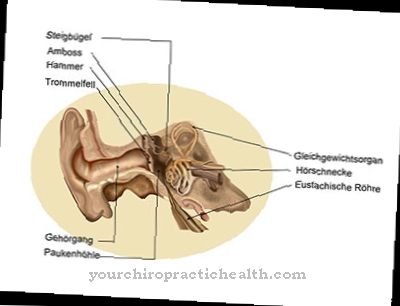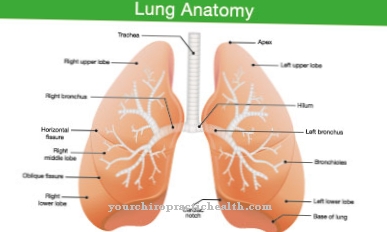The Beckwith-Wiedemann syndrome is characterized by a genetically caused growth disorder of the child with uneven growth of the various organs. This abnormal development already begins intrauterine (in the uterus) and is often associated with the formation of tumors.
What is Beckwith-Wiedemann Syndrome?

© Zffoto - stock.adobe.com
Beckwith-Wiedemann syndrome is a very rare genetic disease and affects children up to the age of eight. There is a 1 in 12,000 to 1 in 15,000 chance of this condition.
Various organs such as the liver, pancreas, spleen or kidneys grow disproportionately. The tongue, too, often enlarges so much that it no longer fits in the mouth. This growth disorder is often accompanied by various benign and malignant tumors.
Furthermore, hypoglycemic conditions (low blood sugar) occur in the first few weeks of life. Other malformations affect the abdominal wall, and umbilical hernias are common. Kidney cysts are also common. After the age of eight, the growth-related symptoms of Beckwith-Wiedemann syndrome disappear again and the likelihood of cancer growth also returns to normal.
causes
The cause of this uneven growth lies in the genetic overproduction of the growth factor IGF-2 (insulin-like growth factor 2). This growth factor has a similar structure to insulin and has a mitogenic (cell-dividing), anti-apoptotic (prevents cell suicide) and growth-stimulating effect.
It can also attach itself to the insulin receptors to a small extent and thus lower the blood sugar level. The increased concentration of IGF-2 thus promotes cell division and thus stimulates growth. At the same time, however, it prevents the destruction of diseased and degenerated cells and also to some extent replaces the role of insulin. The result is an unbalanced growth, which is accompanied by tumors and, in infancy, often by hypoglycaemia.
The genetic causes of the overproduction of the hormone IGM-2 are changes in the genes IGF-2 and H19, which are located on chromosome 11. Normally only the allele of the IGF-2 gene, which comes from the paternal chromosome 11, is active. The corresponding allele on maternal chromosome 11 is usually inactive. The activity of IGF-2 is regulated by the action of the H19 gene. However, if H19 is methylated, as in the paternal (paternal) chromosome 11, the activity of IGF-2 is fully effective. Various mutations lead to Beckwith-Wiedemann syndrome.
Hypermethylation can be present so that both alleles of IGH-2 are active. Furthermore, it is also possible that two paternal chromosomes 11 are inherited without a maternal chromosome 11 being present. In 20 percent of cases, the genetic cause of Beckwith-Wiedemann syndrome cannot be clarified.
Symptoms, ailments & signs
Infants born with Beckwith-Wiedemann syndrome are usually larger and heavier than healthy children. The tall stature often affects the organs and can cause further growth disorders in early childhood. Externally, the syndrome can also be recognized by the too small head and the protruding eyeballs.
The tongue is disproportionately large and leads to the typical speech disorders. Some children also suffer from deformities of the hands and feet or damage to the spine. Defects in the abdominal wall, disorders of the gastrointestinal tract and bone diseases can also occur. Affected infants also suffer from tumors that usually develop shortly after birth or in the first few years of life and grow rapidly.
For many of those affected, the external abnormalities lead to emotional problems such as social anxiety or depression. If the syndrome is treated early, the symptoms can at least be reduced. However, some symptoms such as the short stature of the skull or the protruding eyeballs cannot always be treated.
They cause physical and mental problems throughout life. These include visual disturbances, circulatory disorders, inflammation, bleeding and a number of other symptoms that depend on the type and severity of the symptoms.
diagnosis
Beckwith-Wiedemann syndrome can be diagnosed using typical growth disorders. There is a positive family history in 15 percent of the cases. The other cases are sporadic. If there is macrosomia (disproportionate size of organs and body parts), macroglossia (enlarged tongue), defects in the abdominal wall, at least one enlarged organ and embryonic tumors, one can assume Beckwith-Wiedemann syndrome. Molecular genetic tests should continue to be performed to confirm the diagnosis of Beckwith-Wiedemann syndrome.
Complications
As a rule, Beckwith-Wiedemann syndrome leads to the formation of tumors and thus shortens the lifespan if the disease is not treated properly or not treated early. Often the organs do not grow evenly and the patient's growth is impaired. The patient's organs are greatly enlarged, which can be seen primarily on the tongue.
The enlarged tongue and the too small skull can lead to speech defects during the development of the child. The eyeballs also often protrude. Because of their unusual appearance, children can in many cases become victims of teasing and bullying. Beckwith-Wiedemann syndrome is only treated symptomatically; a specific treatment of the symptom is not possible.
The tumors in particular are monitored and removed if necessary. Since the tumors grow relatively quickly, the affected person has to undergo many surgical procedures. The life of the person affected is severely restricted and the quality of life decreases.
Many patients also suffer from decreased self-esteem due to the changed appearance. If the removal of the tumors is successful, there are no further complications. In most cases, symptoms of Beckwith-Wiedemann syndrome only appear until the age of eight.
When should you go to the doctor?
Beckwith-Wiedemann syndrome can usually be diagnosed immediately after the child is born. The doctor, an obstetrician or the parents will usually notice the typical misalignments immediately and initiate a diagnosis. Further treatment should be carried out as soon as possible. Immediate measures - usually the tumors are first monitored and, if necessary, removed - can at least reduce further complications.
The changes in appearance can only be treated symptomatically. Most of the time, certain malformations remain that can lead to psychological problems later in life. Should the changed appearance lead to exclusion and, as a result, to a reduced self-esteem, a therapist must be consulted.
In addition, there are counseling sessions with specialists and self-help groups with other affected persons. Further medical measures are not necessary if the Beckwith-Wiedemann syndrome regresses as usual. However, if the symptoms persist well beyond the age of eight, you should speak to your doctor again.
Doctors & therapists in your area
Treatment & Therapy
Beckwith-Wiedemann syndrome can only be treated symptomatically as it is genetic. This disease is particularly in need of treatment from the earliest childhood up to the age of eight.
Blood sugar levels must be monitored during infancy to avoid hypoglycaemia. If this occurs too often, it can also lead to brain development disorders. Furthermore, the tumor development, such as Wilms tumor, hepatoblastoma, neuroblastoma and rhabdomyosarcoma, must be constantly checked. These tumors grow very quickly and must be removed surgically.
To control the development of tumors, it is necessary to have blood tests every six to twelve weeks up to the age of 4 years and ultrasound examinations of the abdomen every three months up to the age of 8 years. At the age of eight, the symptoms of Beckwith-Wiedemann syndrome then disappear.
Outlook & forecast
Beckwith-Wiedemann syndrome has an unfavorable course of the disease. The prognosis for the genetic disease is considered to be very poor, as there are insufficient treatment options for permanent recovery. For legal reasons, interference and modification of human genetics are not yet permitted.
This limits the medical professionals' options and only allows symptomatic treatment. Scientists and researchers, despite great efforts, are not yet able to achieve a lasting cure or minimize the symptoms.
Children are particularly at risk. The risk of premature death within the first 8 years of life is significantly increased. It also rises sharply if no medical treatment is received. In addition to growth disorders, tumors repeatedly form in various parts of the body. These often have malignant disease and rapid growth.
The child must undergo regular examinations so that the formation of a tumor can be determined at an early stage. There are already several operations in childhood. The growth disorders are corrected as well as possible and the tumors are removed. Every surgical procedure is associated with the usual risks and side effects. When the patient reaches adulthood, tumor formation usually decreases. Nevertheless, there is still an increased risk of death.
prevention
Prevention of Beckwith-Wiedemann syndrome is not possible because it is genetic. Up to the age of eight, however, the child needs constant medical monitoring in order to prevent life-threatening undesirable developments.
prevention
Beckwith-Wiedemann syndrome must be treated for a lifetime, since the malformations and tumors often cause long-term consequences. Follow-up care focuses on the actions that need to be taken after surgery. In the case of tumors, in addition to conservative therapeutic measures, alternative means must also be considered.
Especially during aftercare, methods from Chinese medicine can provide pain relief and improved well-being. The doctor responsible can support the patient in finding a suitable alternative doctor and give further tips for a healthy lifestyle that is adapted to the condition. In addition, the usual follow-up checks must be made.
Depending on the patient's state of health, these examinations can take place weekly, monthly or yearly. Any wounds need to be checked after an operation. Follow-up care after chemotherapy or radiation therapy also includes ultrasound examinations, measurements of blood values and patient discussions.
Genetic counseling is also part of the follow-up care. In conversation with a specialist in genetic diseases, the risk of recurrence is assessed, among other things. If the patient is expecting offspring, the risk of the child becoming ill must be weighed up. Under certain circumstances, an ultrasound scan can provide information about the child's health.
You can do that yourself
Parents of sick children should inform themselves comprehensively about Beckwith-Wiedemann syndrome at an early stage so that they know what to expect after the birth of their child and they can take the necessary organizational measures in good time.
Childcare places for small children in need of care are extremely scarce. Parents should therefore arrange for their child to be placed as early as possible. However, it is to be expected that both parents will not be able to return to their jobs promptly or full-time, as caring for a child suffering from Beckwith-Wiedemann syndrome is very expensive, especially up to the age of eight.
The children usually suffer from a large number of tumors and cysts, which require constant monitoring and medical control, so that regular visits to the doctor and hospital stays must be integrated into the everyday life of the family. Affected families can best learn how to do this from people in a comparable situation. Since Beckwith-Wiedemann syndrome is very rare, there are no disease-specific self-help groups, but parents can join groups for diseases with similar symptoms.
With increasing age, the children themselves suffer from the limitations that come with their illness. Because of their striking appearance, they are often teased or bullied by their peers. In order to cope better with this situation, parents should consult a child psychologist in good time.

.jpg)
.jpg)
























